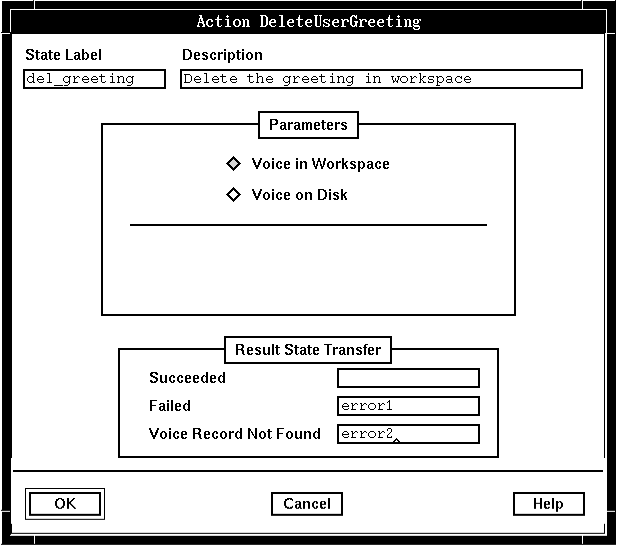Purpose
Use DeleteUserGreeting to delete the voice data that speaks a particular greeting for a specific profile ID.

Description
DeleteUserGreeting removes the greeting, either from the temporary workspace in which the system holds it until it is saved, or from disk.
Each application profile can have up to 255 greetings. You can share a greeting among several mailboxes or have one or more greetings assigned to each mailbox. The value in the Caller : Mailbox : Owner status system variable (SV102) can be checked to determine which greeting to play.
Parameters
The parameters for DeleteUserGreeting identify the user greeting to delete and where it is located. This action deletes a greeting either from workspace (Voice in Workspace) or from disk (Voice on Disk). If the voice data is in workspace, there are no parameters. If the greeting is stored on disk, the parameters are:
- Profile ID. Identifies the application profile with which the greeting is associated.
- Greeting ID. Identifies the greeting. Valid values are 1 through 255.
Possible results
DeleteUserGreeting can have one of the following results:
- Succeeded
- The voice data was deleted.
- Failed
- The voice data was not deleted.
- Voice Record Not Found
- The system did not find a greeting for the application profile and greeting defined by the parameters.
ASCII syntax
When using an ASCII editor, code this action with these parameters in the following order:
- "IN_WORKSPACE"
Or:
- "ON_DISK"
- Profile ID
- Greeting ID
For example:
label: "Check Edges"
DeleteUserGreeting("IN_WORKSPACE")
edge EDGE_DELETE_VCE_SUCCESSFUL: successful
edge EDGE_DELETE_VCE_UNSUCCESSFUL: unsuccessful
edge EDGE_DELETE_VCE_NO_VOICE: no_voice
;
DeleteUserGreeting("ON_DISK", SV20, SV108); #SV20...Caller Profile ID
# SV108...Caller Greeting ID
The parameters and edges are described above under "Parameters" and "Possible results". For more information, see Testing a state table using the debugger.